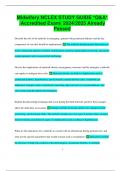Midwifery NCLEX STUDY GUIDE *Q&A*
|Accredited Exam| 2024/2025 Already
Passed
Describe the role of the midwife in managing a patient with gestational diabetes and the key
components of care that should be implemented. The midwife should monitor blood glucose
levels, educate the patient on dietary modifications, promote regular physical activity, and ensure
regular prenatal visits to assess fetal well-being.
Discuss the implications of maternal obesity on pregnancy outcomes and the strategies a midwife
can employ to mitigate these risks. Maternal obesity can lead to complications such as
gestational diabetes, hypertension, and increased cesarean delivery rates. A midwife can
implement strategies such as nutritional counseling, physical activity recommendations, and
close monitoring throughout the pregnancy.
Explain the physiological changes that occur during the third trimester and how these changes
affect the midwifery assessment. Changes include increased uterine size, changes in fetal
positioning, and hormonal shifts. The midwife should assess for signs of preterm labor, monitor
fetal movement, and check for signs of complications such as edema or hypertension.
What are the indications for a midwife to consult with an obstetrician during prenatal care, and
what are the specific parameters that would warrant such a consultation? Indications include
the presence of high-risk conditions like preeclampsia, gestational diabetes, or multiple
1
,gestations. The midwife should consult when there are concerns about maternal or fetal health
that exceed their scope of practice.
Detail the process of conducting a thorough prenatal assessment, including the essential
components that must be documented in the patient's chart. Essential components include
medical history, physical examination findings, laboratory test results, and patient education
provided. Documentation should be clear and comprehensive for continuity of care.
Discuss the importance of cultural competence in midwifery practice and provide examples of
how midwives can incorporate cultural beliefs into care. Cultural competence ensures that
care is respectful of and tailored to the patient's cultural background. Midwives can incorporate
beliefs by asking about cultural practices and preferences during care discussions.
What are the primary considerations a midwife must assess when a laboring woman presents
with abnormal fetal heart rate patterns? The midwife should assess the mother's vital signs,
the nature of the contractions, and any potential causes of the abnormal patterns, such as
maternal position or cord compression, and be prepared to implement interventions as necessary.
Describe the mechanisms of labor and delivery, and outline the midwife's role in facilitating a
natural birth experience. The mechanisms include engagement, descent, flexion, internal
rotation, extension, external rotation, and expulsion. The midwife should support the patient's
position, provide comfort measures, and facilitate effective pushing.
2
,Explain the importance of prenatal education in midwifery and how it contributes to positive
maternal and newborn outcomes. Prenatal education empowers patients with knowledge
about pregnancy, labor, and postpartum care, leading to informed decision-making and better
adherence to care plans.
Discuss the pathophysiology of preeclampsia and the midwifery management strategies that
should be employed in caring for affected clients. Preeclampsia is characterized by
hypertension and proteinuria. Management strategies include monitoring blood pressure,
educating the patient about signs of worsening condition, and planning for potential early
delivery if severe.
What are the signs of postpartum hemorrhage, and how should a midwife prepare to manage this
potential complication? Signs include excessive vaginal bleeding, a boggy uterus, and signs
of shock. The midwife should prepare by having medications, IV access, and uterine massage
techniques ready for immediate intervention.
Describe the management of a breech presentation during labor, including options available to
the midwife for facilitating vaginal delivery. Management options include assessing the type
of breech presentation and considering techniques like external cephalic version or preparing for
a cesarean section if vaginal delivery is not safe.
Discuss the role of midwives in promoting breastfeeding, including the education and support
strategies that should be utilized. Midwives can provide education on breastfeeding
3
, techniques, offer support in the early days postpartum, and help address any challenges the
mother may face, such as latching difficulties.
What are the psychological impacts of miscarriage on patients, and how can midwives provide
appropriate support during this difficult time? Psychological impacts may include grief,
guilt, and anxiety. Midwives should offer compassionate support, provide resources for
counseling, and facilitate discussions about future pregnancies.
Explain the significance of informed consent in midwifery practice and the steps necessary to
ensure patients understand their choices. Informed consent respects patient autonomy and
legal requirements. Steps include providing clear information, answering questions, and ensuring
the patient comprehends the risks and benefits of proposed interventions.
Discuss the benefits and risks associated with home birth, and outline the midwife's
responsibilities in planning and attending a home delivery. Benefits include personalized care
and comfort; risks can include unavailability of emergency services. The midwife is responsible
for thorough assessments, creating a safety plan, and ensuring necessary supplies are available.
What are the potential complications of a prolonged labor, and how should a midwife intervene
when these complications arise? Complications include fetal distress and uterine exhaustion.
The midwife should assess the labor progress and consider interventions such as changing
maternal positions, providing analgesia, or preparing for potential transfer to a hospital.
4




